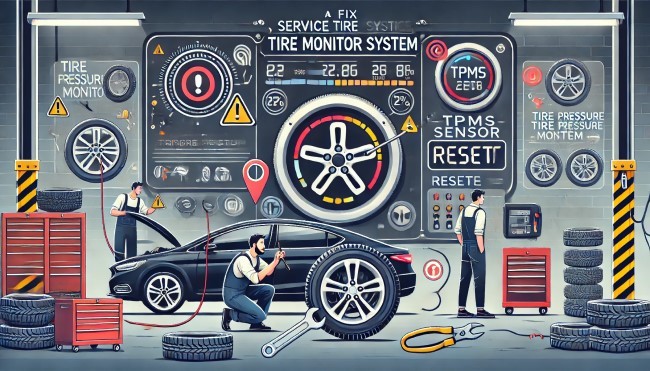Ultimate Guide: How to Fix Service Tire Monitor System Efficiently
Unlocking Solutions to Fix Service Tire Monitor System and Enhance Your Driving Experience

Maintaining your vehicle’s tire pressure monitoring system (TPMS) is crucial for safety and performance. If you’ve encountered the Service Tire Monitor System warning, you’re not alone. This comprehensive guide will provide you with the knowledge and steps needed to address and fix the service tire monitor system effectively.
Understanding the Service Tire Monitor System
What is the Service Tire Monitor System?
The Service Tire Monitor System (TPMS) is a vehicle feature that continuously monitors the air pressure in your tires. It alerts you if any tire is significantly underinflated, which can lead to unsafe driving conditions. Modern vehicles rely on TPMS to ensure optimal tire pressure, enhance fuel efficiency, extend tire life, and improve overall vehicle safety.
Common Causes of Service Tire Monitor System Warnings
- Low Tire Pressure:
- When the tire pressure drops below the recommended level, the TPMS warning light will illuminate.
- Faulty or Dead TPMS Sensor Batteries:
- Sensors have batteries that typically last about five years. Once depleted, they need replacement.
- Damaged TPMS Sensors:
- Physical damage or corrosion can cause sensors to malfunction.
- New Tires or Wheels:
- Installing new tires or wheels may require recalibration of the TPMS sensors.
- Electrical System Issues:
- Problems with the vehicle’s electrical system, including a weak battery, can affect the TPMS.
How to Fix Service Tire Monitor System
Step-by-Step Solutions to Fix Service Tire Monitor System
- Check and Adjust Tire Pressure:
- Start by ensuring all tires are inflated to the recommended pressure. Use a reliable tire pressure gauge for accuracy.
- Inflate tires according to the manufacturer’s specifications, usually found on the driver’s side door jamb or in the vehicle’s manual.
- Reset the TPMS:
- Many vehicles have a TPMS reset button. With the vehicle in the “ON” position (engine off), press and hold the reset button until the TPMS light flashes three times, then start the car and wait about 20 minutes.
- Alternatively, driving the vehicle at a steady speed (above 50 mph) for about 10 minutes can sometimes reset the system.
- Recalibrate the TPMS:
- If you’ve installed new tires or sensors, recalibration might be necessary. Refer to your vehicle’s manual for specific recalibration procedures, or use a TPMS tool.
- Replace Faulty Sensors:
- Identify and replace any faulty sensors. This may involve checking each sensor’s battery and ensuring there is no physical damage or corrosion.
- Replacing sensors can often be a DIY task if you have the appropriate tools and follow the guidelines in your vehicle’s manual.
- Address Electrical Issues:
- Inspect the vehicle’s battery and terminals for any signs of corrosion or poor connections. Clean and secure connections as needed.
- If the battery is weak, consider having it tested and replaced if necessary.
- Seek Professional Assistance:
- If the above steps don’t resolve the issue, it’s advisable to consult a professional mechanic. They can perform a thorough diagnosis using advanced tools and ensure any complex electrical issues are addressed.
Preventive Maintenance for Your Service Tire Monitor System
Regular Tire Pressure Checks
Maintaining correct tire pressure is crucial not only for the TPMS but also for your vehicle’s overall performance and safety. Check tire pressure monthly and before long trips. Use a high-quality tire pressure gauge and adjust pressure according to your vehicle’s specifications.
TPMS Sensor Maintenance
Regularly inspect TPMS sensors for signs of wear, corrosion, or damage. Replace sensors as needed and ensure they are recalibrated properly after installation. Using TPMS-friendly tire sealants can help prolong the life of your sensors.
Battery Health and Electrical System Check
Keep your vehicle’s battery in good health by performing regular checks and cleanings of the terminals. A healthy battery ensures that all electronic systems, including the TPMS, function correctly. Replace the battery every 3-5 years or as recommended by your vehicle’s manufacturer.
Conclusion
Encountering the Service Tire Monitor System warning can be a nuisance, but with the right knowledge and tools, it can be resolved efficiently. By understanding the causes and following the steps outlined in this guide, you can ensure your TPMS functions correctly, enhancing your vehicle’s safety and performance. Regular maintenance and prompt attention to any warnings will keep your vehicle in top shape and provide peace of mind on the road.
This guide is designed to help you navigate and fix the service tire monitor system issues with ease. Implementing these steps will not only resolve current problems but also prevent future occurrences, ensuring a safe and smooth driving experience.



